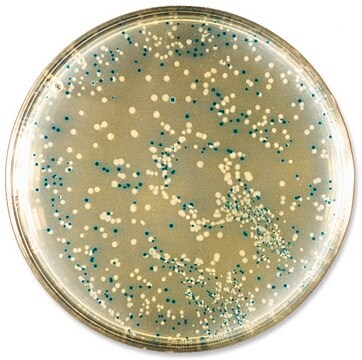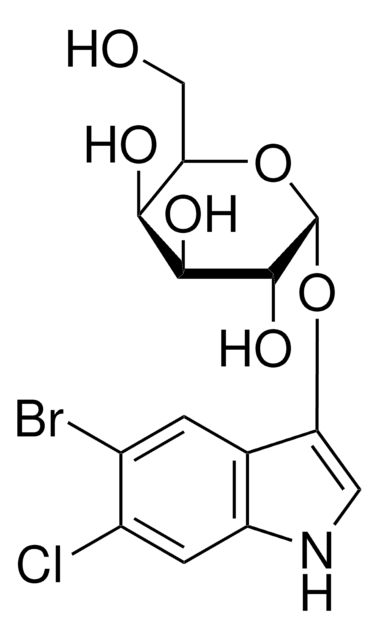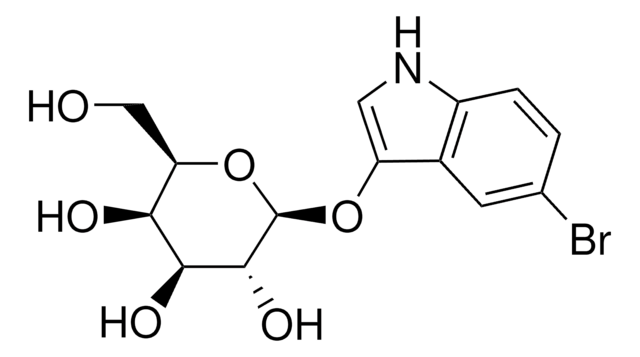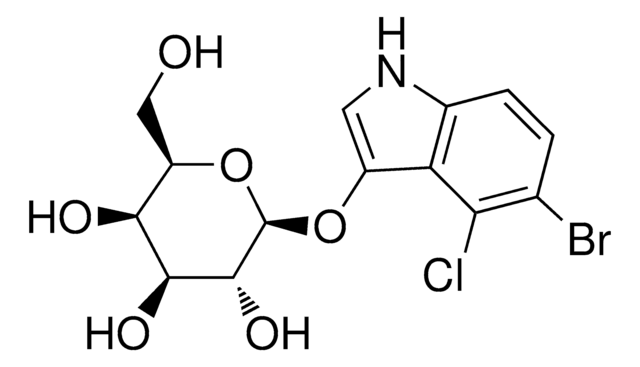추천 제품
Grade
for molecular biology
무균
non-sterile
형태
powder
기술
microbiological culture: suitable
적합성
suitable for β-galactosidase test
nonselective for Escherichia coli
nonselective for coliforms
응용 분야
food and beverages
microbiology
저장 온도
room temp
일반 설명
S-Gal® (sodium salt) is an autoclavable, water-soluble, chromogenic substrate for β-galactosidase, used to determine the presence or absence of a cloned DNA insert in bacteria growing on agar plates. S-gal® is designed to replace X-Gal in blue-white selection of recombinant bacterial colonies with the lac+ phenotype.
애플리케이션
S-Gal®/LB Agar Blend has been used for the identification of recombinant bacterial colonies.
Suitable for use in selection of recombinant bacterial colonies with the lac+ phenotype. S-Gal® (sodium salt) is water-soluble, autoclavable and can be added to bacterial broth containing agar prior to autoclaving.
특징 및 장점
- More intense color contrast than X-gal
- Water-soluble and autoclavable for easiest use
- Convenient, pre-mixed media
성분
Ingredients (g/L)
Tryptone, 10
Yeast extract, 5
Sodium chloride, 10
Agar, 12
S-Gal, 0.3
Ferric ammonium citrate, 0.5
IPTG, 0.03
Tryptone, 10
Yeast extract, 5
Sodium chloride, 10
Agar, 12
S-Gal, 0.3
Ferric ammonium citrate, 0.5
IPTG, 0.03
원리
When S-Gal® is cleaved by β-galactosidase, the resulting product will chelate ferric ion to create a black, insoluble precipitate. Lac+ colonies grown in the presence of S-Gal® and ferric ion turn an intense black color, allowing for easy differentiation between lac+ and lac- colonies.
제조 메모
Suspend contents of one packet in 500 ml distilled or deionized water. Sterilize by autoclaving for 15 to 20 minutes at 121-124°C. For microwaving, heat suspended mix until initial boiling. Mix well. Heat for short intervals with mixing until agar component is in solution. Do not allow boiling for extended periods of time. Antibiotics should be added following autoclaving or microwaving, after cooling to 48-52°C.
기타 정보
The ferric or Fe3+ ion is required for color development and must be added to any S-Gal®
formulation. A medium prepared with S-Gal® is moderately dark due to the presence of ferric ammonium citrate. This darker background often provides enhanced contrast for automated colony counting or isolation.
formulation. A medium prepared with S-Gal® is moderately dark due to the presence of ferric ammonium citrate. This darker background often provides enhanced contrast for automated colony counting or isolation.
법적 정보
S-GAL is a registered trademark of Merck KGaA, Darmstadt, Germany
관련 제품
제품 번호
설명
가격
Storage Class Code
11 - Combustible Solids
WGK
WGK 3
Flash Point (°F)
Not applicable
Flash Point (°C)
Not applicable
개인 보호 장비
Eyeshields, Gloves, type N95 (US)
시험 성적서(COA)
제품의 로트/배치 번호를 입력하여 시험 성적서(COA)을 검색하십시오. 로트 및 배치 번호는 제품 라벨에 있는 ‘로트’ 또는 ‘배치’라는 용어 뒤에서 찾을 수 있습니다.
K Heuermann et al.
BioTechniques, 30(5), 1142-1147 (2001-05-18)
Blue/white selection is the standard method for detecting a cloned DNA fragment. In the absence of an insert, uninterrupted expression of the vector-encoded alpha-complement of beta-galactosidase (beta-gal), results in the hydrolysis of X-gal (5-bromo-4-chloro-3-indolyl-beta-D-galactoside) and the subsequent blue staining of
Differential expression of alphaB-crystallin and Hsp27-1 in anaplastic thyroid carcinomas because of tumor-specific alphaB-crystallin gene (CRYAB) silencing
Mineva I, et al.
Cell Stress & Chaperones, 10(3), 171-171 (2005)
N Martin Young et al.
The Journal of biological chemistry, 277(45), 42530-42539 (2002-08-21)
Mass spectrometry investigations of partially purified Campylobacter jejuni protein PEB3 showed it to be partially modified with an Asn-linked glycan with a mass of 1406 Da and composed of one hexose, five N-acetylhexosamines and a species of mass 228 Da
Heat shock protein 70 (Hsp70) subtype expression in neuroendocrine tissue and identification of a neuroendocrine tumour-specific Hsp70 truncation.
Zierhut B, et al.
Endocrine-related cancer, 11(2), 377-389 (2004)
John Kelly et al.
Journal of bacteriology, 188(7), 2427-2434 (2006-03-21)
In eukaryotes, N-linked protein glycosylation is a universal modification involving addition of preformed oligosaccharides to select Asn-Xaa-Ser/Thr motifs and influencing multiple biological events. We recently demonstrated that Campylobacter jejuni is the first member of the Bacteria to possess an N-linked
자사의 과학자팀은 생명 과학, 재료 과학, 화학 합성, 크로마토그래피, 분석 및 기타 많은 영역을 포함한 모든 과학 분야에 경험이 있습니다..
고객지원팀으로 연락바랍니다.







